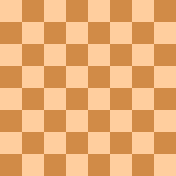
- Chess World Cup
- FIDE Grand Prix
- Olympiad
- World Championship
- List of strong tournaments
- List of world championships

- Checkmate patterns
- Chess openings
- Chess strategy
- Chess tactics
- Chess theory
- Endgames
- Pawn structure
- Problems/Compositions












| a | b | c | d | e | f | g | h | ||
| 8 |

     |
8 | |||||||
| 7 | 7 | ||||||||
| 6 | 6 | ||||||||
| 5 | 5 | ||||||||
| 4 | 4 | ||||||||
| 3 | 3 | ||||||||
| 2 | 2 | ||||||||
| 1 | 1 | ||||||||
| a | b | c | d | e | f | g | h | ||
In chess, a discovered attack is an attack revealed when one piece moves out of the way of another. Discovered attacks can be extremely powerful, as the piece moved can make a threat independently of the piece it reveals. Like many chess tactics, they succeed because the opponent is unable to meet two threats at once. While typically the consequence of a discovered attack is the gain of material, they do not have to do this to be effective; the tactic can be used merely to gain a tempo. If the discovered attack is a check, it is called a discovered check.
When the moving piece gives check to the opponent's king, the maneuver is often described as a discovered attack with check. When the discovered attack is itself a check, it is called a discovered check. If both pieces give check, a double check results.
Discovered attacks - especially checks - can win material when the moving piece captures an opposing piece nominally protected by another opposing piece. If the opponent deals with the discovered attack (obligatory if it is a check), the attacking player will have time to return the moving piece out of harm's way. This scenario is often referred to as a discovered attack (or check) with capture.
When the moving piece moves to a square from which it threatens to inflict checkmate on the next move, the tactic is called a discovered attack with mate threat. A discovered checkmate itself is also possible.
| a | b | c | d | e | f | g | h | ||
| 8 |

                            |
8 | |||||||
| 7 | 7 | ||||||||
| 6 | 6 | ||||||||
| 5 | 5 | ||||||||
| 4 | 4 | ||||||||
| 3 | 3 | ||||||||
| 2 | 2 | ||||||||
| 1 | 1 | ||||||||
| a | b | c | d | e | f | g | h | ||
The diagram illustrates a trap in the Advance Variation of the French Defence, based on a discovered attack. If, after 1.e4 e6 2.d4 d5 3.e5 c5 4.c3 Nc6 5.Nf3 Qb6 6. Bd3 cxd4 7.cxd4, Black mistakenly attempts to win White's d4-pawn with 7...Nxd4?? 8.Nxd4 Qxd4 (diagram), White can play 9.Bb5+, a discovered attack (White's bishop gets out of the way of White's queen) against Black's queen with check. Black must get out of check, then White can follow up with 10.Qxd4.